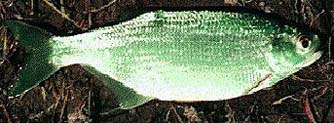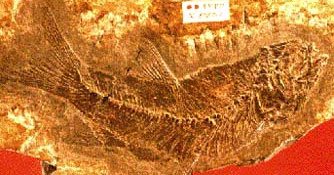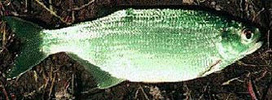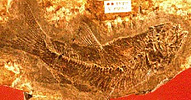Hiodontiformes
Mooneye, Goldeye
Guo-Qing Li and Mark V. H. Wilson


This tree diagram shows the relationships between several groups of organisms.
The root of the current tree connects the organisms featured in this tree to their containing group and the rest of the Tree of Life. The basal branching point in the tree represents the ancestor of the other groups in the tree. This ancestor diversified over time into several descendent subgroups, which are represented as internal nodes and terminal taxa to the right.

You can click on the root to travel down the Tree of Life all the way to the root of all Life, and you can click on the names of descendent subgroups to travel up the Tree of Life all the way to individual species.
For more information on ToL tree formatting, please see Interpreting the Tree or Classification. To learn more about phylogenetic trees, please visit our Phylogenetic Biology pages.
close boxIntroduction
The Hiodontiformes are represented by two extant species, Hiodon alosoides (goldeye) and Hiodon tergisus (mooneye), which occur in fresh waters, both lakes and streams, of the interior of North America east of the Rocky Mountains. These two species are of minor economic importance, but they are reasonably well known among sport fishers.
The earliest fossil Hiodontiformes thus far known in North America are Eocene species of †Eohiodon (Cavender, 1966; Wilson, 1978; Grande, 1979; Li, Wilson, and Grande, 1997). However, in East Asia the record of the group extends back to the Early Cretaceous †Yanbiania (Li, 1987), a genus sister to the clade containing the Eocene †Eohiodon and the Eocene to Recent Hiodon. In addition, recent studies suggest that †Plesiolycoptera (Zhang and Zhou, 1976) is an even more primitive stem-group member of the Hiodontiformes (Li and Wilson, in press).
Characteristics
All hiodontiform fishes share the following synapomorphies:
- Hyomandibular bone double-headed.
- Dermosphenotic bone triradiate.
- Opercle bone an irregular parallelogram.
- Dorsal arm of post-temporal bone more than twice as long as ventral arm.
- Seven-rayed pelvic fin.
Comparison between Hiodon and Eohiodon
The following are some important osteological differences recently identified between ![[Extinct]](/tree/ToLimages/extinct.gif) Eohiodon and Hiodon:
Eohiodon and Hiodon:
- The horizontal arm of the preopercle is proportionally longer in
![[Extinct]](/tree/ToLimages/extinct.gif) Eohiodon than in Hiodon.
Eohiodon than in Hiodon.
-
![[Extinct]](/tree/ToLimages/extinct.gif) Eohiodon has a parallel-sided opercle that is not strongly excavated posteriorly (see Li, Wilson, and Grande, 1997: figure 3-1), while the opercle in Hiodon is strongly excavated both posteriorly and dorsally (see Li and Wilson, 1994, fig. 6).
Eohiodon has a parallel-sided opercle that is not strongly excavated posteriorly (see Li, Wilson, and Grande, 1997: figure 3-1), while the opercle in Hiodon is strongly excavated both posteriorly and dorsally (see Li and Wilson, 1994, fig. 6).
- The upper part of the hyomandibula consists of three equal-sized heads (including the opercular process) in
![[Extinct]](/tree/ToLimages/extinct.gif) Eohiodon (a typical
Eohiodon (a typical ![[Extinct]](/tree/ToLimages/extinct.gif) Eohiodon feature), while in Hiodon the dorsal end of the hyomandibular is bridged (a typical Hiodon feature; see Li, Wilson, and Grande, 1997: figure 4).
Eohiodon feature), while in Hiodon the dorsal end of the hyomandibular is bridged (a typical Hiodon feature; see Li, Wilson, and Grande, 1997: figure 4).
Recent study also suggests that the lower and upper jaws in ![[Extinct]](/tree/ToLimages/extinct.gif) Eohiodon woodruffi appear to be intermediate between those of
Eohiodon woodruffi appear to be intermediate between those of ![[Extinct]](/tree/ToLimages/extinct.gif) Eohiodon rosei and those of Hiodon. The premaxilla in
Eohiodon rosei and those of Hiodon. The premaxilla in ![[Extinct]](/tree/ToLimages/extinct.gif) Eohiodon rosei is similar to that in lycopteriforms and other hiodontiforms, such as
Eohiodon rosei is similar to that in lycopteriforms and other hiodontiforms, such as ![[Extinct]](/tree/ToLimages/extinct.gif) Yanbiania (Li, 1987), in having a raised anterior portion. In Hiodon it is anteriorly only as deep as or even slightly shallower than it is posteriorly. The premaxilla in
Yanbiania (Li, 1987), in having a raised anterior portion. In Hiodon it is anteriorly only as deep as or even slightly shallower than it is posteriorly. The premaxilla in ![[Extinct]](/tree/ToLimages/extinct.gif) Eohiodon woodruffi has only a slightly raised anterior portion. A distinct feature of the premaxilla in Hiodon, including
Eohiodon woodruffi has only a slightly raised anterior portion. A distinct feature of the premaxilla in Hiodon, including ![[Extinct]](/tree/ToLimages/extinct.gif) H. consteniorum (Li and Wilson, 1994), is that it bears a mid-dorsal concavity. The two
H. consteniorum (Li and Wilson, 1994), is that it bears a mid-dorsal concavity. The two ![[Extinct]](/tree/ToLimages/extinct.gif) Eohiodon species do not share this character state with Hiodon.
Eohiodon species do not share this character state with Hiodon.
It should be noticed that in some features of the jaws and infraorbital series, ![[Extinct]](/tree/ToLimages/extinct.gif) Eohiodon woodruffi is more similar to Hiodon tergisus than it is to
Eohiodon woodruffi is more similar to Hiodon tergisus than it is to ![[Extinct]](/tree/ToLimages/extinct.gif) Eohiodon rosei and Hiodon alosoides. As in Hiodon tergisus, the posterior end of the maxilla in
Eohiodon rosei and Hiodon alosoides. As in Hiodon tergisus, the posterior end of the maxilla in ![[Extinct]](/tree/ToLimages/extinct.gif) Eohiodon woodruffi extends back to beyond the vertical midline of the orbit, usually reaching to the level of the posterior one third of the orbit. Correspondingly, the corner of the mouth gape in
Eohiodon woodruffi extends back to beyond the vertical midline of the orbit, usually reaching to the level of the posterior one third of the orbit. Correspondingly, the corner of the mouth gape in ![[Extinct]](/tree/ToLimages/extinct.gif) Eohiodon woodruffi is located at a level near the vertical midline of the orbit. The general outline of the infraorbital series of
Eohiodon woodruffi is located at a level near the vertical midline of the orbit. The general outline of the infraorbital series of ![[Extinct]](/tree/ToLimages/extinct.gif) Eohiodon woodruffi (see Li, Wilson, and Grande, 1997: figure 3-2) is basically the same as that of the extant species Hiodon tergisus, in which the two posterior infraorbitals (io3 and io4-5) are deeper than long, forming a relatively shorter cheek region than in Hiodon alosoides.
Eohiodon woodruffi (see Li, Wilson, and Grande, 1997: figure 3-2) is basically the same as that of the extant species Hiodon tergisus, in which the two posterior infraorbitals (io3 and io4-5) are deeper than long, forming a relatively shorter cheek region than in Hiodon alosoides.
Discussion of Phylogenetic Relationships
The Hiodontiformes contain four valid genera: Hiodon (Lesueur, 1818), ![]() Eohiodon (Cavender, 1966),
Eohiodon (Cavender, 1966), ![]() Yanbiania (Li, 1987), and
Yanbiania (Li, 1987), and ![]() Plesiolycoptera (Zhang and Zhou, 1976).
Plesiolycoptera (Zhang and Zhou, 1976).
Previous studies suggested that ![]() Eohiodon closely resembles
Eohiodon closely resembles ![]() Hiodon in osteology (Cavender, 1966; Wilson, 1977, 1978; Grande, 1979; Li and Wilson, 1994), for example in having a caudal skeleton almost identical to that of Hiodon (see Li, Wilson, and Grande, 1997: figure 5). Recently, Li (1994), Li and Wilson (1994, 1996) and Li, Wilson, and Grande (1997) further clarified that Hiodon is sister to the fossil genus
Hiodon in osteology (Cavender, 1966; Wilson, 1977, 1978; Grande, 1979; Li and Wilson, 1994), for example in having a caudal skeleton almost identical to that of Hiodon (see Li, Wilson, and Grande, 1997: figure 5). Recently, Li (1994), Li and Wilson (1994, 1996) and Li, Wilson, and Grande (1997) further clarified that Hiodon is sister to the fossil genus ![]() Eohiodon. This relationship is supported by at least two synapomorphies uniquely shared by these two genera in the Hiodontiformes sensu stricto Li and Wilson (1996): supraorbital canal ending in frontal, anal fin in male and female sexually dimorphic.
Eohiodon. This relationship is supported by at least two synapomorphies uniquely shared by these two genera in the Hiodontiformes sensu stricto Li and Wilson (1996): supraorbital canal ending in frontal, anal fin in male and female sexually dimorphic.
![]() Yanbiania was originally considered to be an early member of the Hiodontidae based on features from the parasphenoid, the basihyal tooth plate, and the caudal skeleton (see Li, 1987). After comparison with North American Eocene
Yanbiania was originally considered to be an early member of the Hiodontidae based on features from the parasphenoid, the basihyal tooth plate, and the caudal skeleton (see Li, 1987). After comparison with North American Eocene ![]() Eohiodon and extant Hiodon, a sister-group relationship was recognized between
Eohiodon and extant Hiodon, a sister-group relationship was recognized between ![]() Yanbiania and
Yanbiania and ![]() Eohiodon plus Hiodon based on five derived features:
Eohiodon plus Hiodon based on five derived features:
- Dermosphenotic bone triradiate.
- Opercle bone an irregular parallelogram.
- Dorsal arm of post-temporal bone more than twice as long as ventral arm.
- Hyomandibular bone double-headed.
- Pelvic fin with seven rays.
These synapomorphies define the Hiodontiformes (Li and Wilson, 1996a). A complete specimen of ![]() Yanbiania recently collected from the type locality confirms the presence of all five synapomorphies.
Yanbiania recently collected from the type locality confirms the presence of all five synapomorphies. ![]() Yanbiania Li 1987 thus demonstrates that the Hiodontiformes had already diverged by Early Cretaceous times.
Yanbiania Li 1987 thus demonstrates that the Hiodontiformes had already diverged by Early Cretaceous times.
The early Late Cretaceous genus ![]() Plesiolycoptera has an infraorbital series most similar to that in extant Hiodon (see Li, 1987; Li and Wilson, in press). The most important feature supporting a hiodontiform relationship of
Plesiolycoptera has an infraorbital series most similar to that in extant Hiodon (see Li, 1987; Li and Wilson, in press). The most important feature supporting a hiodontiform relationship of ![]() Plesiolycoptera is the triradiate dermosphenotic, which is unique to the Hiodontiformes among teleosts (Li 1994a, Li and Wilson, 1996a). Another important feature supporting a hiodontiform relationship of
Plesiolycoptera is the triradiate dermosphenotic, which is unique to the Hiodontiformes among teleosts (Li 1994a, Li and Wilson, 1996a). Another important feature supporting a hiodontiform relationship of ![]() Plesiolycoptera is the "L"-shaped post-temporal with a dorsal arm at least twice as long as the ventral arm. This is seen in all hiodontiform species and is also unique to the order (Li and Wilson, 1996a, in press; Li, Wilson, and Grande, 1997). In addition, seven-rayed pelvic fins are found in
Plesiolycoptera is the "L"-shaped post-temporal with a dorsal arm at least twice as long as the ventral arm. This is seen in all hiodontiform species and is also unique to the order (Li and Wilson, 1996a, in press; Li, Wilson, and Grande, 1997). In addition, seven-rayed pelvic fins are found in ![]() Plesiolycoptera. This feature characterizes all species included in the Hiodontiformes (Li and Wilson, in press). Further studies of the systematic position of
Plesiolycoptera. This feature characterizes all species included in the Hiodontiformes (Li and Wilson, in press). Further studies of the systematic position of ![]() Plesiolycoptera require recovery of better-preserved specimens.
Plesiolycoptera require recovery of better-preserved specimens.
Biogeography
Living species of hiodontiforms are endemic to interior fresh waters of North America east of the Rocky Mountains. However, fossil evidence indicates that the ancient geographic range of this group includes East Asia (from Early Cretaceous to Early Tertiary, see Zhang and Zhou, 1976; Sytchevskaya, 1986; Li, 1987) and far western North America (Early Tertiary, see Cavender, 1966; Wilson, 1978; Grande, 1979; Li and Wilson, 1994; Li, Wilson, and Grande, 1997). Extinction must have been important in the Cenozoic history of the order (Li, Wilson, and Grande, 1997): the present endemic distribution of the Hiodontiformes is thus a remnant of a former widespread northern hemispheric distribution (Wilson and Williams, 1993).
References
Arratia, G. 1996. The Jurassic and the early history of teleosts. In: ARRATIA, G. & VIOHL, G. (eds.): Mesozoic Fishes - Systematics and Paleoecology, p. 243-259. Verlag Dr. Pfeil, München.
Arratia, G. 1997. Basal teleosts and teleostean phylogeny. - Palaeo Ichthyol., 7: 5-168.
Cavender, T. 1966. Systematic position of the North American Eocene fish, "Leuciscus" rosei Hussakof. - Copeia, 1966: 311-320.
Chang, M.-M. and Chou, C.-C. 1977. On Late Mesozoic Fossil Fishes from Zhejiang Province, China. -Inst. Vert. Paleon. Paleoanth., Acad. Sinica, Mem., 12: 1-59. (In Chinese with English abstract)
Grande, L. 1979. Eohiodon falcatus, a new species of hiodontid (Pisces) from the late early Eocene Green River Formation of Wyoming. J. Paleont., 53: 103-111.
Grande, L. 1985. Recent and fossil clupeomorph fishes with materials for revision of the subgroups of clupeoids. Bull. Amer. Mus. Nat. Hist., 181: 231-372.
Grande, L. and Cavender, T. M. 1991. Description and phylogenetic reassessment of the monotypic †Ostariostomidae (Teleostei). J. Vert. Paleont., 11: 405-416.
Greenwood, P. H. 1970. On the genus Lycoptera and its relationship with the family Hiodontidae (Pisces, Osteoglossomorpha). - Bull. Brit. Mus. (Nat. Hist.), Zool., 19: 257-285.
Greenwood, P. H.; D. E. Rosen, S. H. Weitaman, and G. S. Myers. 1966. Phyletic studies of teleostean fishes, with a provisional classification of living forms. Bull. Amer. Mus. Nat. Hist., 131: 339-456.
Jin, F. 1991. A new genus and species of Hiodontidae from Xintai, Shandong. -Vert. PalAsit., 29: 46-54. (In Chinese with English abstract)
Jin, F. 1994. A nomen novum for Tanichthys JIN 1991. -Vert. PalAsit., 32: 70.
Jin, F.; Zhange, J.-Y.; & Zhou, Z.-H. 1993. A review of Longdeichthys (Teleostei: ?Clupeocephala) from northern China. . -Vert. PalAsit., 31: 241-256. (In Chinese with English abstract)
Jin, F.; Zhange, J.-Y.; and Zhou, Z.-H. 1995. Late Mesozoic fish fauna from western Liaoning, China. -Vert. PalAsit., 33: 169-193. (In Chinese with English abstract)
Li, G.-Q. 1987. A new genus of Hiodontidae from Luozigou Basin, east Jilin. -Vert. PalAsit., 25: 91-107. (In Chinese with English abstract)
Li, G.-Q. 1994a. New Osteoglossomorphs (Teleostei) from the Upper Cretaceous and Lower Tertiary of North America and Their Phylogenetic Significance. - Ph. D. Thesis, University of Alberta, Canada, 290 pp.
Li, G.-Q. 1994b. Systematic position of the Australian fossil osteoglossid fish †Phareodus (=†Phareoides) queenslandicus HILLS. -Mem. Queensl. Mus., 37: 287-300.
Li, G.-Q. 1996. A new species of Late Cretaceous osteoglossid (Teleostei) from the Oldman Formation of Alberta, Canada, and its phylogenetic relationships. In: Arratia, G. and Viohl, G. (eds.): Mesozoic Fishes - Systematics and Paleoecology, p. 285-298. Verlag Dr. Pfeil, München.
Li, G.-Q. 1997. Notes on the historical biogeography of the Osteoglossomorpha (Teleostei). In: Proceedings of the 30th International Geological Congress. VSP International Science Publishers, Zeist, The Netherlands: 54-66.
Li, G.-Q. and Wilson, M. V. H. 1994. An Eocene species of Hiodon from Montana, its phylogenetic relationships, and the evolution of the postcranial skeleton in the Hiodontidae (Teleostei). -J. Vert. Paleont., 14: 153-167.
Li, G.-Q. and Wilson, M. V. H. 1996a. Phylogeny of Osteoglossomorpha. In: Stiassny, M. L. J.; Parenti, L. R.; and Johnson, G. D. (eds.): Interrelationships of Fishes, 1996: 163-174; San Diego, London, Boston, New York, Sydney, Tokyo, Toronto, 496 pp.
Li, G.-Q. and Wilson, M. V. H. 1996b. The discovery of Heterotidae (Teleostei: Osteoglossidae) from the Paleocene Paskapoo Formation of Alberta, Canada. - J. Vert. Paleont., 16: 198-209.
Li, G.-Q.; Grande, L.; & Wilson, M. V. H. 1997. The species of †Phareodus (Teleostei: Osteoglossidae) from the Eocene of North America and their phylogenetic relationships. -J. Vert. Paleont., 17: 487-505.
Li, G.-Q.; Wilson, M. V. H. ; and Grande, L. 1997. Review of †Eohiodon (Teleostei: Osteoglossomorpha) from western North America, with a phylogenetic reassessment of Hiodontidae. J. Paleont., 71: 1109-1124. (USA)
Liu, X.-T.; Ma, F.-Z; and Liu, Z.-C. 1982. Pisces. -In: Geological Survey of Inner Mongolia (ed.): The Mesozoic Stratigraphy and Paleontology of the Guyang Coal-bearing Basin, Inner Mongolia, 1982: 101-122, plate 21-28; Beijing (Geological Press). (In Chinese)
Ma, F.-Z. 1980. A new genus of Lycopteridae from Ningxia, China. -Vert. PalAsiat., 18: 286-295. (In Chinese with English abstract)
Ma, F.-Z. 1993. Late Mesozoic Fossil Fishes from the Jiuquan Basin of Gansu Province, China. - Ocean Press, Beijing, China. 118 pp. (In Chinese with English abstract)
Mcallister, D. E. 1968. Evolution of branchiostegals and classification of teleostome fishes. Bull. Nat. Mus. Can., 221: 1-239.
Müller, J. 1847. Fossile Fische. In "Reise in den aussersten norder und osten Sibiriens wahrend der Jahre 1843 und 1844 (Erster Band) (A. Th. Von Middendorff, ed.), pp. 260-264. Buchdruckerei der Kaiserlichen Akademie der Wissenschaften, St. Petersburg.
Su, D.-Z. 1991. A new fossil hiodontoid fish from Fuxin Group of western Liaoning, China. - Vert. PalAsit., 29: 38-45. (In Chinese with English abstract)
Sytchevskaya, E. K. 1986. Palaeogene freshwater fish fauna of the USSR and Mongolia. The Joint Soviet-Mongolia Paleontological Expedition (Transactions), 29: 1-157. (In Russian)
Takai, F. 1943. A monograph on the lycopterid fishes from the Mesozoic of eastern Asia. J. Fac. Sci., Imp. Univ. Tokyo, Sec. II (Geol., Min., Geog., Seism.), 6: 207-270.
Taverne, L. 1972. Ostéologie des genres Mormyrus Linné, Mormyrops Müller, Hyperopisus Gill, Isichthys Gill, Myomyrus Boulenger, Stomatorhinus Boulenger et Gymnarchus Cuvier: Considérations générales sur la systématique des poissons de l'ordre des Mormyriformes. Mus. Roy. L'Afr. Cent. - Terv., Belg. Ann. - Serie IN-8º - Sci. Zool. 200: 1-194.
Taverne, L. 1977. Ostéologie, phylogénese et systématique des téléostéens fossiles et actuels du super-ordre des ostéoglossomorphes. Premiere Partie. Acad. Roy. Belg., Mém. Cla. Sci., XLII-Fascicule 3: 1-235.
Taverne, L. 1978. Ostéologie, phylogénese et systématique des téléostéens fossiles et actuels du super-ordre des ostéoglossomorphes. Deuxieme Partie. - Acad. Roy. Belg., Mém. Cla. Sci., XLII-Fascicule 6: 1-213.
Wilson, M. V. H. 1978. Eohiodon woodruffi n. sp. (Teleostei, Hiodontidae) from the middle Eocene Klondike Mountain Formation near Republic, Washington. - Can. J. Earth Sci., 15: 679-686.
Yabumoto, Y. 1994. Early Cretaceous freshwater fish fauna in Kyushu, Japan. - Bull. Kitakyushu Mus. Nat. Hist., 13: 107-254.
Wilson, M. V. H. & Williams, R. R. G. 1993. Phylogenetic, biogeographic, and ecological significance of early fossil records of North American freshwater teleostean fishes. In: Mayden, R. L. (ed.): Systematics, Historical Ecology, and North American Freshwater fishes, pp. 224-244. Stanford University Press, Stanford, California.
Zhang, M.-M. and Zhou, C.-C. 1976. Discovery of Plesiolycoptera in Songhuajiang-Liaoning Basin and origin of Osteoglossomorpha. -Vert. PalAsiat., 14: 146-133. (In Chinese)
Note: Chang, M.-M. = Zhang, M.-M.; Chou, C.-C. = Zhou, J.-J.
Title Illustrations

Representatives of the Hiodontiformes.
About This Page

Chinese Academy of Sciences, Beijing , China

University of Alberta, Edmonton, Alberta, Canada
Correspondence regarding this page should be directed to Guo-Qing Li at and Mark V. H. Wilson at
Page copyright © 1998 and
All Rights Reserved.
- First online 06 October 1998
Citing this page:
Li, Guo-Qing and Mark V. H. Wilson. 1998. Hiodontiformes. Mooneye, Goldeye. Version 06 October 1998. http://tolweb.org/Hiodontiformes/15131/1998.10.06 in The Tree of Life Web Project, http://tolweb.org/










 Go to quick links
Go to quick search
Go to navigation for this section of the ToL site
Go to detailed links for the ToL site
Go to quick links
Go to quick search
Go to navigation for this section of the ToL site
Go to detailed links for the ToL site